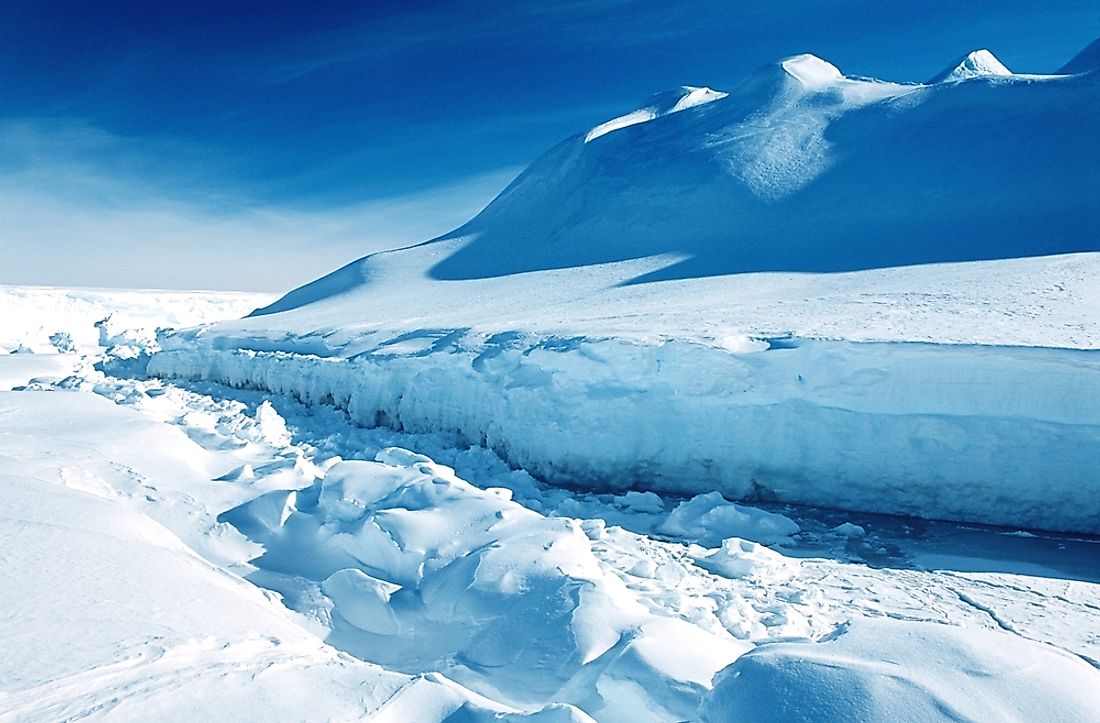What Is An Ice Shelf And Where Are They Found?

Ice shelves are thick floating ice platforms attached to the land. The ice is also grounded along the coastline. The nature of the coastline affects the size and position of an ice shelf by providing pinning points to help ground the ice shelf. Ice shelves may have a thickness of between 300 to 6000 feet. The seaward edge (ice front) of the ice shelf is thinner than the edge towards the land. Ice shelves are formed from ice streams and flowing glaciers, surface accumulation of snow, and freezing seawater on the bottom of the ice shelf. Ice shelves are vital in the maintenance of stability in glacial systems. The stability is maintained as the ice shelves act as barriers to glacial melt. The world’s ice shelves are primarily found in Greenland, Canada, Antarctica, and the Arctic part of Russia.
Canadian Ice Shelves
The Canadian ice shelves are found attached along the Ellesmere Island on its northwestern coast. The ice shelves cover in the country has receded significantly in the past century leaving about one-tenth of the original size. Some of the major Canadian ice shelves include Serson, Milne, Petersen, Ayles, Markham ice, and Ward Hunt shelves. The Ayles and Markham ice shelves underwent massive calving and are no longer in existence.
Antarctic Ice Shelves
Ice shelves cover about 75% of the coastline of Antarctica and cover a total area of 595, 254 square feet. Antarctica has many ice shelves some covering extensive areas. The major ice shelves on the Antarctic include the Ross Ice Shelf, which covers an area of 182,611 square miles the Filchner-Ronne ice shelf with an area of 163,097 square miles. The two are the largest ice shelves on the Antarctic by area. The rest of the major ice shelves occupy an area of less than 14,907 square miles. These ice shelves include Amery, George VI, Riiser-Larsen, Larsen, Fimbul, West, Shackleton, and Wilkins. Some of the ice shelves have collapsed including Larsen (Larsen A), Prince Gustav, Müller, Jones and Wordie ice shelves.
Russian Ice Shelves
The most significant ice shelf on the Russian Arctic is the 86-squared mile Matusevich ice shelf, which has also been the subject of several studies on the behavior of ice shelves. From the 1930s, the Matusevich ice shelf disintegrated so often at a rate of one in approximately thirty years. Since the last collapse between 2007 and 2012, the ice shelf has undergone significant area loss with less than half of the original area remaining by the end of 2013. Some of the factors that accelerated the ice shelf collapse include warmer ocean temperatures leading to bottom melt, mechanical weakness of the ice shelf, warm sea surface temperatures and melt ponds on the ice shelf.
Processes Involved In Ice Shelf Break-up
Ice shelves break up due to processes such as calving, fracturing, climate change and stress patterns. Calving is a significant process that contributes to ice shelf break up. In calving, vast chunks of ice shelf break apart and float away on the ocean after which they disintegrate rapidly. The rise in global atmospheric temperatures has played a significant role in the rapid retreat of ice shelves especially in the Antarctic region. Studies indicate that the disintegration of ice shelves would not result in a significant rise in sea levels. However, their disintegration accelerates the rate of glacial melt thus increasing the volume of seawater which will result in the rise of sea level.











